This post contains affiliate links. We may get paid an affiliate commission if you buy something or take an action after clicking one of the links on this web page.
This article is part of a series of interviews I am conducting with with custom knifemakers and craftsmen. I will be exploring the world of custom knives and the people who make them. If you or someone you know would be interested in being interviewed by BladeReviews please contact me.
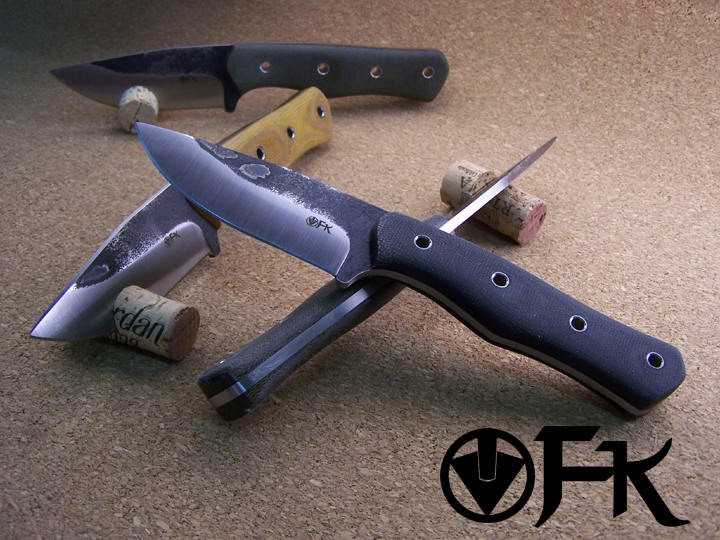
Dylan Fletcher of Fletcher Knives is a custom knifemaker out of Alpharetta, Georgia. His hard use tools are rugged, reliable and are built to simply get the job done. I recently had the pleasure of chatting with Dylan and found him to be a very laid back and funny guy who is also incredibly passionate about what he does. I think you will find his story to be both interesting and inspirational so it is with great pride that I welcome Dylan to BladeReviews.com
Hi Dylan, great to have you with us. I’ve been following your work for a while and your knives are obviously built to be used. Can you tell us what got you into making them?
I’ve been an avid knife collector and user since I was a little slugger. It was always very important in my family that the kids learned proper knife and gun safety and usage as soon as we could understand English. I remember my father saying over and over, “always cut away from your body, never towards you.” I was very lucky to have a family that cared a lot more about making sure I knew how to handle weapons/tools than keeping me away from them. However, it wasn’t until I hit 5 years old that I really began to appreciate knives for their aesthetic appeal. Up to that point, I just used kitchen knives and whatever “plain-Jane” fixed blade or folder my father or grandfather happened to hand to me.
I remember very clearly how it all started. (mist and wavy vision into a flashback…) I was walking home from my friend, Nicky’s house. I lived in a cul-de-sac on a street named Squirrel Tree Place in Tampa, Florida. (I remember the strangest things. Ask me what my crossing guards name was from elementary school and I’ll give you every detail about the man’s life, including his social and phone number in 1987, but ask me where I left the remote and I’ll scratch my head for about ten minutes with a goofy look.) Anyways, I was walking home and something caught my eye in the grass. I picked it up and it was a folding small stiletto style lock-back. It had black hard plastic scales, a bayonet style blade and a swing guard. It had a total length of about 5″ and a blade maybe 2.25″ long. As far as I was concerned, it was the most beautiful thing I’d ever seen. My mind instantly told me, “finders keepers good buddy!” I took it in the house, showed it to my parents and asked if I could keep it. My mom, still not wanting her little dude playing with sharp stuff unsupervised quite yet said, “No. We’ll put it in the drawer and maybe you can have it later.”
For a couple of years after that, I was still limited to the supervised usage of whatever unsatisfying knife I was handed for chores and meals. I was convinced that they’d forgotten about that knife, but I never did. Every once in a while I would search through those “junk drawers” in the kitchen just so I could keep up with where it was. Every time I’d pull it out and announce, “LOOK WHAT I FOUND! How bout that, it’s still here! Can I have it yet?” Finally one day, they gave in. The rest is history as they say.
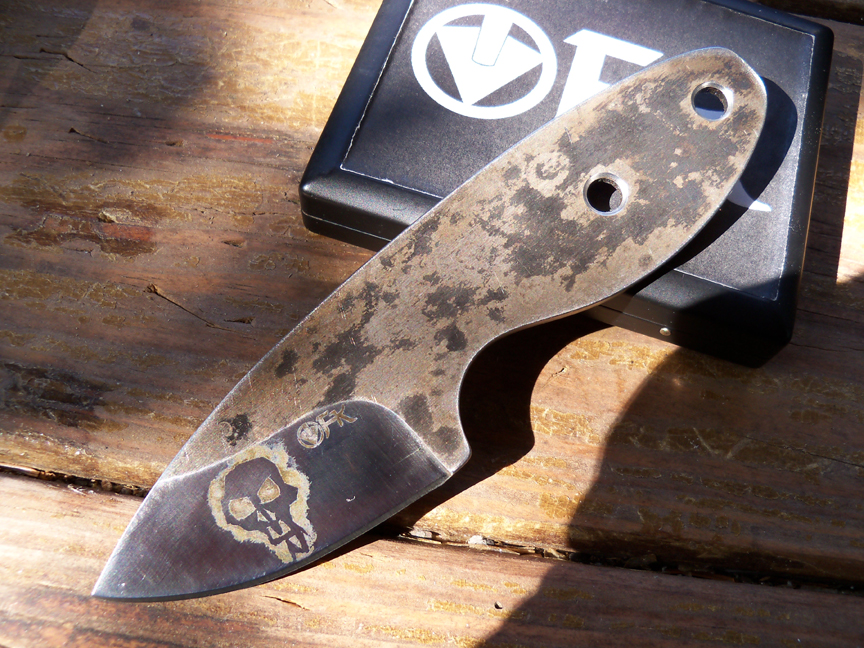
After that, I began collecting knives where ever I could get them. It didn’t take long for me to put together a pretty decent collection of relatively respectable sharp stuff. It also didn’t take long for me to start setting my standards higher and higher as far as knives and gear in general. I was a country boy, always outside exploring and camping with my trusty bb gun and favorite knives. With that lifestyle, pretty quickly I realized that quality was important. Those gas station cheapies and gun show specials wouldn’t hold up past the first cut so I had to throw down serious loot to get the good stuff. …or talk somebody into buying some birthday or Christmas presents.
Skip to a few years ago (as if this story wasn’t long enough) I’m cruising around Bladeforums, learning how to make kydex sheaths. I had several knives with no sheaths and needed a solution. I bought or put together all the necessary equipment and started making kydex sheaths. Before I knew it, other people wanted them too. Quickly, my sheaths caught on with the purpose built crowd. They were simple and rugged. Eventually, some of the custom knifemakers started to check them out too. That’s how I met Andy Roy of Fiddleback Forge.
Andy sends me an email one day asking about kydex sheaths. We get to talking and he tells me that his shop is really close to me and I should come by for dinner one night and check it out. Now bear in mind, I’ve got no idea what kind of dude this is. I imagined this old man with a big bushy beard, dirty overalls, and a cigar stink fog all around him. Now, I’m not one to judge. Besides, those kind of dudes usually have some fine home-grown corn whiskey residing in mason jars around the house. Not that I’m one to endorse that kind of thing. … Anyways, Andy later told me, he was just as off with his idea of me too. At the time, I was going through the selection process for a police department and that’s all he really knew. So, he was expecting to see this big bad cop show up.
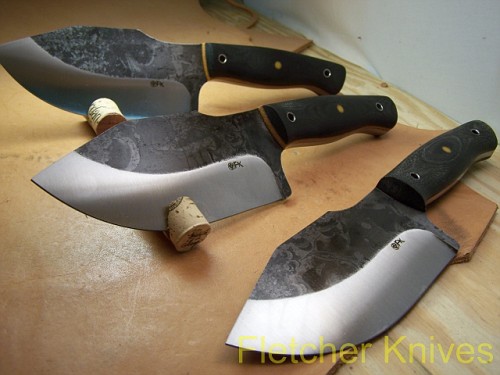
When I knocked on his door, this young guy, only slightly older than me and way too normal looking answers the door. I half thought about asking, “is your dad around?” Andy looks at me funny and says, “you’re Dylan?” I said, “yep, that’s me.” You have to understand, he was expecting a tightass cop, and the dummie standing on his porch has tattoos everywhere and giant earrings in both ears. I would imagine that was a little confusing. He and his wife treated me to a damn fine meal and with no shortage of beer he showed me around the shop. That’s when I first laid eyes on a KMG (a heavy duty industrial grinder used to make knives -Ed.). Man, what a sexy metal beast. Andy and I ended up having a lot in common and became fast friends.
Instead of asking me to make sheaths for him, he started suggesting that I try making a knife. I had tried making some file knives at home, but nothing I wanted to show to anyone. Wellll… that’s not entirely true. I took those ugly bastards to Blade Show back in 2009 and showed them to just about everyone that would stand still long enough. I tell ya what, if I could take anything back it would be that. I wish I had never shown those to ANYBODY. Andy kept telling me, I’ll teach you how to make knives if you want to learn. In exchange, you can help me do grunt work around the shop. Eventually I decided to take him up on it.
At first, he didn’t really ask me to do much. I’d show up on my days off when I could get them and give him a hand, and in the process learn a little bit more. After a while I started showing up every week. One day, Andy says to me, “sweep up the floor.” I knew what that really meant. I was now his apprentice. Keep in mind, there are a lot of knifemakers in GA and Andy wasn’t the first one to ask me if I wanted to learn how to make knives. Anyone who has seen the tools from Fiddleback Forge knows that Andy does some of the best Convex grinds and handles in the country. He is truly one of the greats when it comes to old school and outdoors styles. He’s known literally all over the world as a master of comfortable knife handles. I’d seen his work for a good while and heard what everyone had to say about it. I knew that if there was someone to learn from, this was the dude. So that’s it. I went full-time in May of 2010 and Andy and I now share a shop.
Man, talk about a hell of a long story right? hahaha.
Dylan, I’ll agree that is a hell of a story. Very cool. I’d be interested to hear how you made your transition from part time knifemaker to full time.
That decision was made for me by the economy. I had been working in a really nice motorcycle shop as a salesman for the past few years, pushing Ducatis, Aprilias and Moto Guzzis. I had a lifelong history with bikes so it was easy and I was really good at it. Well unfortunately, as of 2009, it didn’t matter how good you were as a salesdummy. Nobody was buying expensive toys, at least not enough to make a living at it. Now, I loved everyone that I worked with and still consider them all great friends. I can honestly say that it was the best job I’ve ever had, and I liked every single person that worked there. None the less, I figured out one day that I actually no longer had anything to lose financially. Even if knifemaking didn’t work out, I’d be no worse off than I already was so I thought what the hell.
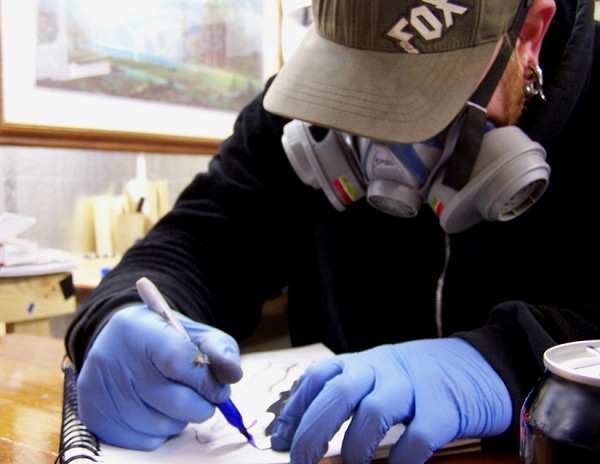
Thanks to help from my father, I managed to score myself a KMG. I had a bunch of other tools, but in this business, if you don’t have the serious toys, you just can’t make it work as a full-time maker. Luckily, I was also blessed with a very understanding and supportive wife. Had it not been for her, I doubt I would be a full-time knifemaker now. It takes a good woman to let her stupid husband chase a dream of doing whatever he wants for the rest of his life. She’s still waiting for it to pay off for her, and I keep telling her it will… some day. hahaha. I finally quit working at the motorcycle shop right before Blade Show last year and went full-time. Somehow, by the grace of the good lord, my knives actually took off. Now, almost every knife I make has a name written on it before it ever even takes shape. I usually have one or two up for grabs every month or so, as I try to make a few extras so people who aren’t previous customers can get a chance at them, but they all sell out in no time. I thank God every day that it has worked out so well.
In these times, it’s great to hear a success story like that. Do you have any advice for anyone who is considering becoming a full time knifemaker?
I sure do. If you have a good, stable job with health care, STICK WITH IT. I can tell you that I DEFINITELY would not be making knives if I had a good steady job that allowed me to provide for a family. However, if you don’t have a good job, are a youngin who doesn’t have the strain of adult bills, or the allure of knifemaking is just too much to resist, find a knifemaker who will show you the ropes.
Honestly, there are tons of good knifemakers out there who are more than willing to teach a newbie the process. Some offer real-deal apprenticeships and some just want someone to help them out. Either way, knifemakers who are willing to teach are a lot more common than people think. Most knifemakers, or really any tradesman in the world, knows that it’s his duty to pass the trade on and keep it alive.
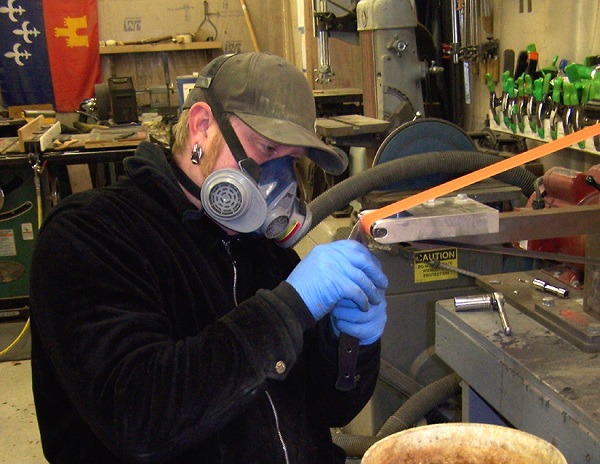
If you can’t find someone to show you how to make knives, read up on it and look for tutorials on the internet. There are tons of them around. They aren’t near as good as having a real person there to show you technique, but they’re better than nothing. You don’t even have to have big boy tools. I’ve seen guys make some pretty killer knives with nothing more than a piece of steel, a couple of hand files, a cheap BBQ grill, the oven in their kitchen, and some handle material from the backyard.
Lets move back to your knives, tell us a little about the philosophy behind your designs.
The philosophy is pretty simple. I design and make knives for users. They’re meant to be comfortable, durable, and efficient. Throughout my life, I’ve had enough experience to know what works and what doesn’t. I apply that to my designs and create things that work. A lot of my designs come from all the ideas I’ve had over the years of what my perfect knife would be for various situations. If you need a knife for bushcraft, you got it. If you need an EDC knife that’s easily concealed, no problem. If you need to cut yourself out of the tank you’re stuck in, got that covered too. None of them are show pieces, but they sure do work.
I also get a lot of input and feedback from bushcraft guys, hunter/outdoorsman, military and LEO’s. In fact, the Bush Operator and Bush Operator XL were both designed with direct input from Special Forces soldiers, Operators, and law enforcement.. Everyone will notice that the Bush Operator line of knives definitely has a more tactical and “serious business” look to them. Every feature that went into those knives came from someone in the military or law enforcement saying, “Dylan, I wish that someone made a knife that had …. or was ….” ALL aspects from the number of pins in the handle, to the design of the guard/leverage point, to the sheathing and concealability all came from them. At the same time, I wanted to make sure that the military and LEO guys that were getting them would also be getting a good woods-bumming knife for when they were camping and trekking around the woods back at home. In my opinion, that line of knives is a great bridge between tactical application and bushcraft. With those, you get the best of both worlds. I’m very proud of the Bush Operator line.
Another aspect is the cost. I have always been a knife user who drooled over the expensive customs, but never able to afford them. I do my best to give maximum bang for the buck. I want my customers to feel like they got more knife than they paid for.
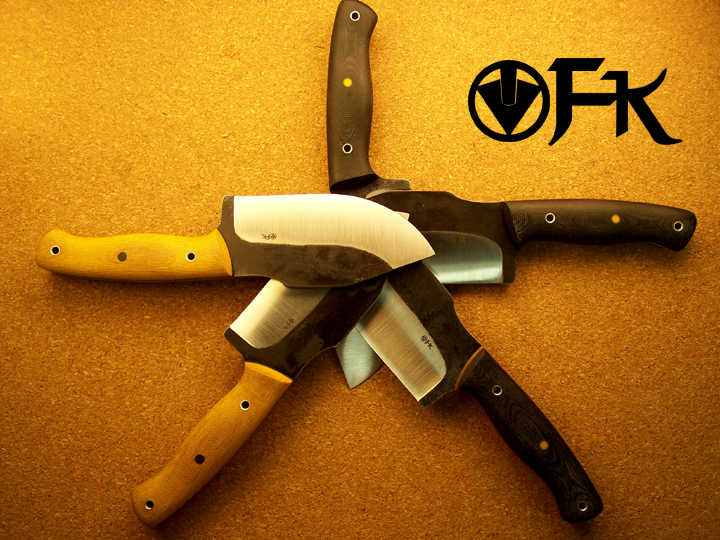
Plus, I want them to know that they just purchased that knife for the last time, which is why I offer a killer warranty. If that knife or tool fails, it will be fixed or replaced, plain and simple. I treat my customers the way I want to be treated, best value at a fair price and fully backed by the person that made it. To give a little credit, I base a lot of my own business practices and philosophy on the good people of ESEE. In my opinion, Jeff Randall, Mike Perrin, Shon Rowen, and all the people involved in ESEE are THE model of how a business should be run.
With a philosophy like that, it’s no wonder you have so many repeat customers. And I have to admit, I think your prices are very doable – even for the average guy.
What kind of steel do you use?
I use a few different steels. I’ve tried my hands at several, but I’ve narrowed it down to a few that I really like to work with. At the moment, I go between O-1, 5160, 440C, and 1095. My absolute favorite is O-1. I love that stuff. It’s funny, that was the first steel, other than files, that I ever used to make a knife. I was told that it was the easiest to learn with and was very forgiving. In the end, I also discovered that, done correctly, it was some of the best tool steel you could use to make a knife, period. It has the best of everything I like, edge holding, ease of sharpening, and it looks awesome with a good patina. I’ve used some stainlesses like 440C and A-2, but I just love the way that a good carbon steel ages. It really develops that character that you just don’t get in stainless.
I agree that if you take care of the knife you really can’t beat carbon steel. What is your method for making your knives, forging or stock removal?
All of my knives are stock removal. I honestly don’t think that I could make a living forging. You have to take ten times more time forging and making each knife. That means you have to charge a bunch more. That also means you have to get the right customer that wants to drop that much cheese on a knife like the one you made. It’s all just too lengthy. I can bust out 25 to 30 knives a month and sell them all lightening fast because they’re affordable. No waiting around, no hoping the right customer comes along with tons of money burning a hole in his pocket, just go go go. Another knifemaking buddy of mine said to me just the other day, “dude, you need to slow down. You’re going to burn yourself out.” Truth be told, I goof around a lot and take my sweet ass time. I’m in NO danger of snuffing out my passion for knives and making them. Every time I finish a batch, I have to force myself to sell them. I always get a huge sense of accomplishment that is hard to match.
I’ve noticed you appear to be a fan of the convex saber grind. Any particular reason?
I really think it’s the best all around grind for hard use knives. It’s an absolutely awesome utilitarian grind, super tough, yet if done correctly, can make a hell of a slicer. Also, I think it’s the hardest of the grinds to do correctly and I love it for that challenging aspect. I’ve heard and read people say, “oh convex grinds are the easiest.” They are the easiest to mess up. A lot of knife people out there do really shady “convex grinds”. To do a perfect one takes some serious skill. There isn’t a rest or clamp that I know of to help you, nothing to make it easy. You can always tell the difference between a convex grind, and a well executed convex grind. A lot of times you’ll see poor plunges, accidental grinding all the way up and onto the spine, tons of hand sanding to cover up wavy and uneven grinds. Every one of my knives are ground free-hand, by eye, with a rotary platen on a KMG. Almost every single one of them is what we call a convex saber grind, meaning the grind does not go full height. You can clearly see how even and straight the grind is and how far up the blade it goes. To me, it’s the same concept as a chef plating a dish. Sure, the food might taste good no matter what the plate looks like, but if the plating is really good, that shows the amount of pride they take in their skill and execution.
I know right now a bunch of people are saying, “what an arrogant bastard.” hahahaha! I’m really a humble dude. I swear.
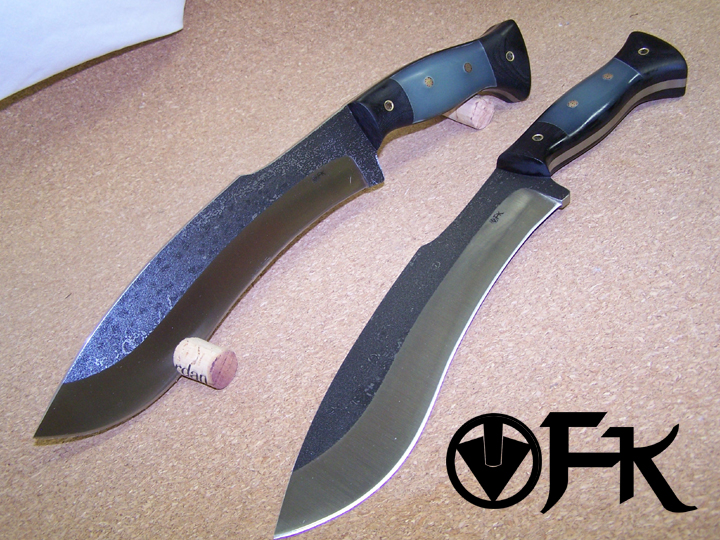
Hey man, that is a way better answer than I ever would have expected. Your passion for knifemaking really shows through, and I think that will win you way more friends than enemies.
And I gotta admit, that forged finish looks great against that shiny saber grind. I also like how you sharpen all of the knives by hand, it’s a nice little detail.
Yep. The finish on most of my knives is just the forging scale leftover from the heat treat process. Sometimes I also do a finish I call “Ghost Scale.” I’d tell you how it’s done, but then I’d have to kill ya. haha.
Hand sharpening my knives is another one of those “matter of pride” things for me. I really appreciate the process of using stones and hand tools to sharpen a blade as apposed to whatever the latest sharpening doodad or contraption is. Don’t get me wrong. Some of those doodads, whichamadoodles, doohickies, etc. can get blades plenty hair-popping sharp, but it just doesn’t have the same connection with the steel and the history for me. I respect the process of hand sharpening more as a skill. I try to steer everyone towards learning to sharpen knives by hand simply because I think it’s a good skill to have. I actually enjoy doing it. Some people play solitaire, make model airplanes, twiddle their thumbs… I like to sharpen my knives. It’s a fun activity I can do by myself and it keeps me from getting bored. I’ve tried just about all of the new-fangled devices for sharpening at some time or another, but I always pass them onto someone else pretty quickly and go right back to my stones and strop. Currently, I like to use DMT plated stones or a Smith’s dual sided sharpener and a leather strop with green honing paste.
Keeping edged tools sharp is one of the oldest skills known to man. These days very few from the general population can sharpen an edge by hand. It’s got a very “zen” type quality to it and it’s a skill I still struggle with myself.
Can you tell us a bit about your heat treating process? What kind of hardness do you like to get the knives to?
My preferred hardness really depends on the steel and what the knife will be used for. The majority of my knives are O-1 and get heat treated to a Rockwell hardness of 60-61rc. All I can tell you is that I’ve done a lot of experimenting to get the results just right. I can’t give all the trade secrets away, now can I? Oh, and I use a Paragon oven and quench in peanut oil. The peanut oil really makes the shop smell good on heat treat day. Although, it means I have to ask everyone that comes to the shop if they have a peanut allergy. I’m not sure, but I think they might die in there if they do. Basic logic tells me that has got to be a bad combo.
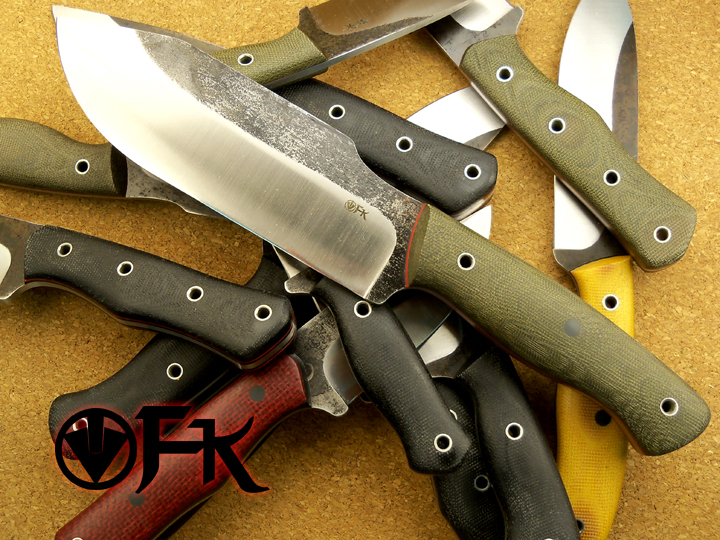
From start to finish, how much time would you say goes into a standard Fletcher knife?
Total time on one knife is about 4 to 5 hours. I’ve gotten to where I can do them pretty quick. I do all of them in batches though, unless I have something special that needs to get busted out for a birthday or Christmas. For the really big knives like the Ulysses, it takes a lot longer. The grinds are harder to do cleanly the larger the blade gets, and if you add curves, it’s even more difficult.
What are you currently carrying every day?
Right now I carry a Bush Operator every day. Not every task needs a fixed blade knife though, so I also carry a Zero Tolerance ZT0301. The ZT gets the majority of the dirty jobs like cutting box tape and scribing lines in steel. Tough little folder. I recommend them. It should also be said that I’m never out of arms reach of an ESEE-3 or ESEE-4. I still buy factory knives and they’re still my favorite.
I’m also a big fan of ESEE knives and the ZT0300 series; solid choices. Thanks so much for your time, is there anything else you would like to add?
I would like to thank all of my supporters and customers. They are the ones that continue to make it possible for me to chase my dream of making knives. Hopefully I can keep them interested and using my tools. I’d like to thank my mother and father too. They were the main reason I was able to get started and continue to help out where ever they can.
Also, 2011 is going to be a huge year for Fletcher Knives in terms of growth. I’m already adding several knives to the line-up that aren’t on the website yet and there’s going to be a lot more to come. Fletcher Knives is currently working on a production line with an awesome USA local manufacturing company. Blade Show is going to be a big deal. Andy Roy and I are both going to have meets, dinners, and some impressive tables. You can always find us at Bladeforums.com and find Fletcher Knives at JerzeeDevil.com. As always, if anyone has any questions, suggestions, etc. feel free to contact me. I’m just a regular dude and I’m never too busy for anyone. Everyone’s questions and opinions are important to me. Thanks again and God bless!
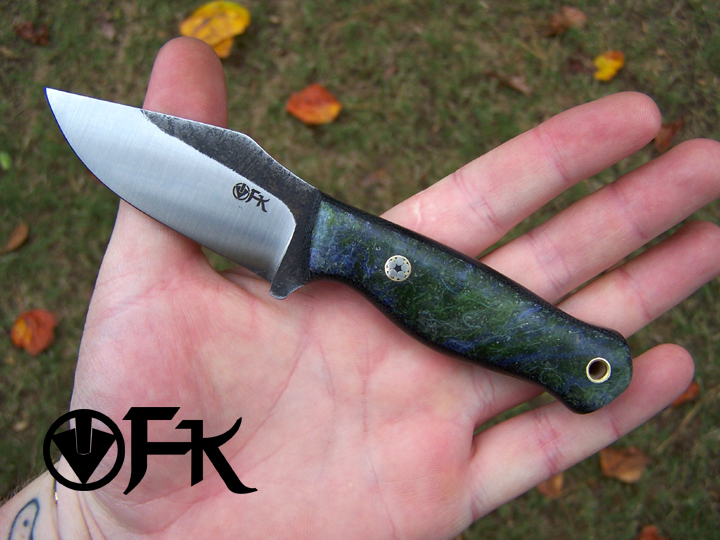
Thanks again for the awesome interview Dylan, all the best in your knifemaking endeavors.
You can learn more about Fletcher knives (including where to get one of your own) at Dylan’s website http://fletcherknives.com or by checking out his forum at bladeforums.com or at JerzeeDevil.
Leave a Reply